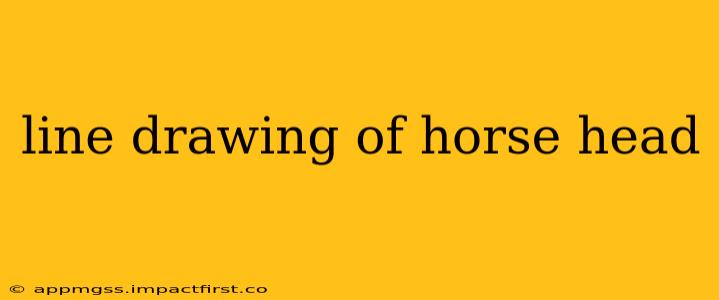Creating a line drawing of a horse head is a rewarding challenge for artists of all skill levels. The elegance and power of the equine form lend themselves beautifully to the simplicity and expressiveness of line art. This guide will explore various techniques, styles, and considerations for achieving a captivating horse head line drawing.
What are the Different Styles of Line Drawing for a Horse Head?
The style of your horse head line drawing will significantly impact its final look and feel. Several popular styles exist, each offering unique aesthetic qualities:
-
Realistic: This style aims for accurate anatomical representation. It often involves detailed rendering of muscles, bone structure, and hair texture using varied line weights and shading techniques.
-
Impressionistic: This style focuses on capturing the essence of the horse rather than precise detail. Loose, expressive lines convey movement, emotion, and form with a less rigid approach.
-
Minimalist: Here, simplicity is key. Only the most essential lines are used to define the horse's form. This style often relies on negative space to create a striking image.
-
Cartoon/Stylized: This is a playful and expressive style, often characterized by exaggerated features and simplified forms.
How to Draw a Horse Head in Pencil: A Step-by-Step Guide
While various mediums can be used (ink, charcoal, etc.), pencil remains a popular choice for its versatility and ease of use. Here's a simplified approach to drawing a realistic horse head:
-
Start with basic shapes: Begin by sketching lightly with a pencil, outlining the head with simple geometric shapes like circles and ovals to establish the overall proportions.
-
Define the muzzle and jaw: Refine the initial shapes, focusing on the muzzle's structure and the powerful jawline.
-
Add the eyes and ears: Carefully place the eyes and ears, ensuring they are proportionally accurate and positioned correctly. Horses' eyes are expressive; capture that essence through line variation.
-
Outline the mane and forelock: Use flowing, dynamic lines to depict the mane and forelock, paying attention to their texture and direction.
-
Refine the details: Gradually refine the drawing, adding details like nostrils, the mouth, and the hairline. Vary line weight to create depth and shadow.
-
Erase construction lines: Once you are satisfied with the overall drawing, carefully erase any unnecessary guidelines.
What are the Best Materials for Line Drawing a Horse Head?
Choosing the right materials can enhance the quality of your line drawing. Consider these options:
-
Pencils: A range of pencils (H for hard, B for soft) will allow for varying line weights and shading.
-
Pens: Fineliner pens are excellent for creating clean, precise lines. Brush pens offer more flexibility and allow for expressive strokes.
-
Ink: Ink offers rich, bold lines, but requires more precision and control.
-
Paper: Choose a paper that is suitable for your chosen medium. Smooth paper works well for pen and ink, while textured paper can be used with pencils or charcoal.
How Can I Improve My Horse Head Line Drawings?
Consistent practice and observation are crucial for improving your horse head line drawings. Consider these tips:
-
Study anatomy: Understanding the underlying anatomy of the horse's head is essential for creating accurate and believable drawings.
-
Observe real horses: Spend time observing horses in person or from photographs. Pay attention to their expressions, movements, and individual features.
-
Use references: Utilize reference images to guide your drawing, but don't simply copy; aim to understand the underlying structure.
-
Experiment with different styles: Try different techniques and styles to discover what works best for you.
What are Some Common Mistakes to Avoid When Drawing a Horse Head?
-
Incorrect proportions: Ensure accurate proportions of the head, ears, muzzle, and eyes.
-
Lack of expression: Convey the emotion and character of the horse through the eyes and overall composition.
-
Inconsistent line weight: Varying line weight creates depth and visual interest.
-
Ignoring negative space: The empty areas around the horse are as important as the horse itself; use them to your advantage.
By following these tips and practicing regularly, you can create beautiful and expressive line drawings of horse heads. Remember, the most important aspect is to enjoy the process and let your creativity flow.
